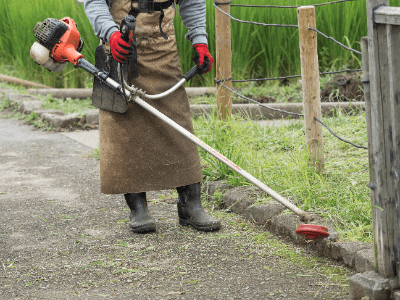What Is a Weed Eater?

A weed eater is a machine used to cut grass and branches.
They are powered by an engine or battery. Weed eaters can be used for a wide range of tasks, from yard maintenance to clearing underbrush in forestry. Most of them are equipped with a shoulder belt and work by moving the blade at the tip while holding the handle.
There is also a hand-pushed type with wheels and a handle, but this section describes those that are used for weed eater work by holding the handle. There is a national certification for the handling of weed eater, which is called “weed eater operator.”
This certification is not required for individuals who use small weed eater, but is necessary when mowing for business purposes.
Usage of Weed Eaters
Weed eaters are used for a wide range of applications, such as cutting weeds in the home, weeds in the fields, cutting underbrush in the forests, and cutting bamboo grass. Depending on the application, engine displacement, power, and blade type vary. In recent years, small and inexpensive models have become available, making it possible for ordinary households to own one.
While they are easy to use, they also carry the risk of injury and accident, so care must be taken when using them. Safety knowledge and equipment are essential to prevent injuries from contact with the blade itself and accidents caused by flying rocks (e.g., damage to car glass due to injuries or flying rocks).
Weed eater specifications have been improved to make it safer to work with, and many weed eaters now stop rotating when the handle is released.
Principle of Weed Eaters
Weed eaters are available in different shapes and sizes, depending on the power source and the shape of the handle. However, regardless of the type of power or the shape of the handle, power is used to rotate the blade. The blade rotated by power is generally used to cut a given object.
Faster and larger blades can cut more grass and other materials at once. At the same time, the weight of the machine increases because it requires more power, and a reasonable amount of physical strength is also required. There is a clutch between the power source and the rotating blade, which shuts off the power to the blade when the work is overloaded or at low speeds.
The blade can be changed according to what is to be harvested and the surrounding conditions. By changing the blades, the weed eater can be adapted to different situations.
Types of Weed Eaters
Classification by Power
Weed eaters are mainly powered by engine, cord and rechargeable batteries.
Engine Type
The engine type is powerful and suitable for serious work, but it is difficult to maintain and handle. Also, the engine is noisy, so care must be taken to avoid noise in urban areas.
Lightweight and easy-to-handle 2-stroke engines are the most common type, but 4-stroke engines are also used for environmental friendliness and noise reduction.
Cord Type
Corded engines are less noisy and can be used in residential areas without hesitation. There is no need to worry about running out of fuel or battery charge.
However, since a power source is required for the work area, it can only be used within the reach of the power cord, and care must be taken not to cut the cord while working.
Rechargeable type
Like the corded type, the rechargeable type is quiet and can be used in residential areas. If the battery capacity is small, it is light and easy to handle, making it suitable for garden maintenance.
The disadvantage, however, is that the continuous working time is short. A larger battery capacity can work for a longer period, but the weight increases and the initial cost is high.
2. Classification by Handle Shape
There are three main types of handles: two-handled, loop handle (2-grip handle), and backpack.
Two-Handed Handle
The U-shaped handle is held with both hands. It is easy to move the handle from side to side, making it suitable for work on flat surfaces. It has a simple structure and is widely used.
Loop Handle (2-Grip Handle)
A weed eater with a loop handle is suitable for use on sloping terrain. Since the weed eater is lifted up, the angle of the blade can be adjusted precisely and small movements are possible. It is also good for working in tight spaces because of its small turning radius.
Back-Carrying Type
This type of machine can be operated by carrying the main body on your back and holding the handle in your hand. The advantage of the backpack type is that it is suitable for work on sloping terrain. Since the heavy power unit is carried on the back, it is less tiring and suitable for long hours of work. The main types are mainly available in large displacement models.